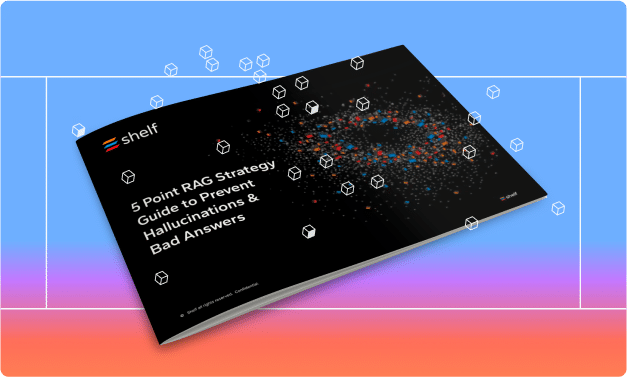As the use of Retrieval-Augmented Generation (RAG) systems becomes more common in countless industries, ensuring their performance and fairness has become more critical than ever.
RAG systems, which enhance content generation by integrating retrieval mechanisms, are powerful tools to improve information accuracy and relevance. However, without thorough audits, these systems can perpetuate biases, inaccuracies, and other issues.
In this article, we outline a comprehensive, step-by-step approach to auditing RAG systems. By following these guidelines, you can ensure that your RAG systems operate ethically, accurately, and effectively.
10 Steps to Conduct a Data Audit for a RAG System
Here’s how you can conduct data audits specifically for a Retrieval-Augmented Generation (RAG) system, focusing on your company’s content to ensure the system remains bias-free, toxicity-free, and responsible.
1. Define Objectives and Criteria
Conducting an audit of a RAG system begins with a clear understanding of what you aim to achieve and how you will measure success. This step ensures that the audit is focused, systematic, and aligned with your organization’s goals.
Establish Goals
Start by outlining specific objectives for the audit, tailored to your company’s content. For instance, you may aim to identify and mitigate biases related to customer demographics, such as ensuring the system fairly represents diverse age groups, ethnicities, or genders. Another goal could be to ensure the comprehensiveness of product information.
Set Criteria
Define what constitutes high-quality, unbiased, and comprehensive data within the scope of your organization’s needs. This involves setting benchmarks for various aspects such as fairness, diversity, and relevance. For example:
- You might establish criteria to evaluate the fairness of the system by ensuring it provides equal representation and avoids stereotypes.
- Diversity criteria could include ensuring a wide range of sources and perspectives are included.
- Relevance criteria might focus on the accuracy and applicability of the retrieved content to the queries posed.
2. Assemble an Audit Team
Next, you’ll need a team to conduct the audit. This team should encompass a diverse range of expertise to effectively address all aspects of system performance, bias, and ethical considerations.
Diverse Expertise
Form a team that includes members with diverse expertise. This multifaceted team ensures a holistic approach to evaluating and improving the RAG system.
- Data scientists bring technical proficiency in evaluating algorithms and performance.
- Domain experts understand the specific content and context of your business.
- Ethicists provide insights into potential biases and ethical implications of the system.
- Legal professionals ensure compliance with regulations and standards.
Training
Equip team members with the necessary training to perform their roles effectively. This includes training in bias detection to recognize and mitigate potential biases in the system. Additionally, team members should be well-versed in ethics in AI to understand the broader implications of their findings and recommendations.
Familiarity with the specifics of RAG systems and your company’s content is also essential, as it ensures that the team can accurately assess the system’s performance and relevance.
3. Collect and Analyze Metadata
Thoroughly collecting and analyzing metadata helps ensure that the data feeding the system is comprehensive, relevant, and of high quality.
Data Source Exploration
Start by documenting all content sources within the company, including internal databases, official documentation, user-generated content, and other knowledge bases. Understanding these sources helps identify potential biases and data gaps.
For instance, if the system heavily relies on user-generated content, the diversity and representativeness of this data must be considered to avoid skewed outputs. A thorough inventory of data sources ensures the audit covers all necessary information.
Metadata Inspection
Analyze the metadata to understand key characteristics such as data freshness, authorship, and context. Assessing data freshness ensures the system uses current information. Investigating authorship can uncover biases from specific content creators, while evaluating context ensures appropriate data usage. Additionally, check for completeness and integrity to identify any missing or inconsistent information.
4. Statistical and Exploratory Data Analysis
Performing statistical and exploratory data analysis helps identify patterns, anomalies, and gaps in the data. This helps you create a thorough evaluation of the system’s underlying content.
Descriptive Statistics
Start by generating descriptive statistics for various content attributes. This includes measures such as mean, median, mode, standard deviation, and frequency counts. Analyzing these statistics helps identify anomalies or imbalances in the data.
For example, if certain topics are significantly underrepresented or if there is a high variance in data quality, these issues can be flagged for further investigation. This creates a clear snapshot of the data’s characteristics and highlights areas needing attention.
Visualizations
Visualizations help in understanding the diversity and coverage of topics, making it easier to spot underrepresented areas or content clusters. Tools such as histograms, bar charts, and heatmaps can reveal the overall landscape of your company’s content.
For instance, a heatmap could show the frequency of specific topics over time, indicating trends or shifts in content focus. These insights are crucial for ensuring the RAG system has a balanced and comprehensive data foundation.
5. Bias Detection Techniques
Bias detection techniques ensure that a RAG system operates fairly and ethically. This step involves evaluating the system’s performance across different contexts and identifying any biases present in the data or outputs.
Subgroup Analysis
Start by evaluating content retrieval and generation performance across various customer demographics, product lines, or service areas. This helps identify disparities in how the system performs for different groups.
For instance, analyze whether the system retrieves and generates content equally well for all age groups or whether certain product lines receive less accurate or relevant information. Identifying these disparities is the first step in addressing potential biases in the system.
Content Analysis
Conduct a thorough content analysis to detect biased language, stereotypes, or toxic content in the retrieved and generated outputs. This involves examining the language and context of the content to ensure it is free from harmful biases and stereotypes.
For example, look for gendered language or cultural stereotypes that may have been inadvertently included. Detecting and addressing these issues is crucial for maintaining the ethical integrity of the RAG system.
6. Gap Identification
Identifying gaps in the data makes sure your RAG system covers all necessary information. This step helps to highlight areas that need improvement to enhance the system’s overall performance and reliability.
Coverage Theory
Begin by assessing whether all essential business scenarios, customer inquiries, and product details are adequately represented in the content. This involves reviewing the scope of the data to ensure that it includes information on key areas of interest.
For example, check if the content covers common customer questions, detailed product specifications, and various business use cases. Complete coverage helps the RAG system provide accurate and relevant responses across all scenarios.
Cluster Analysis
Clustering methods help identify underrepresented topics or areas within the company’s knowledge base. Clustering algorithms can group similar pieces of content together, highlighting areas with sparse or insufficient data. For instance, a cluster analysis might reveal that certain customer concerns are not well-represented or that specific product features lack detailed documentation.
7. Perform Ethical and Contextual Review
Conducting an ethical and contextual review ensures the system aligns with ethical standards and effectively handles real-world scenarios.
Ethical Considerations
Review content from an ethical perspective to ensure it upholds customer privacy, consent, and company values. This involves checking that…
- Personal data is handled appropriately.
- User consent is obtained where necessary.
- Content aligns with the ethical standards of the organization.
For example, you should ensure that the system does not inadvertently share private information or generate content that could harm user trust.
Scenario Testing
Test specific real-world scenarios to evaluate the RAG system’s ability to generate unbiased and accurate responses. Scenario testing helps identify biases and inaccuracies so the system performs reliably and equitably across different contexts.
This involves creating diverse test cases reflecting actual customer inquiries and business situations. For instance, test the system’s responses to inquiries from different demographic groups or about various product features.
8. Implement Remediation Steps
After identifying gaps and biases, remediation can enhance the RAG system’s performance and fairness.
Data Augmentation
Enrich the existing content pool with additional, diverse sources to fill identified gaps and balance the representation of various topics. This could involve incorporating new data from reputable sources, adding underrepresented topics, or expanding the coverage of existing ones.
For example, if certain customer demographics are underrepresented, seek out additional content that reflects these groups.
Filtering and Cleaning
Filter out or rectify outdated, biased, or irrelevant content that could negatively impact the RAG system’s performance. This process includes identifying and eliminating content that no longer applies or that contains harmful biases.
Resampling
Techniques like oversampling or undersampling can balance the dataset and ensure equal representation of key content areas. Oversampling involves increasing the frequency of underrepresented data, while undersampling reduces the overrepresented data. These techniques help create a more balanced dataset, improving the system’s ability to generate fair and accurate responses.
9. Document and Report Findings
Thoroughly documenting and transparently reporting the audit findings is essential for accountability and continuous improvement of the RAG system.
Comprehensive Reporting
Document the entire audit process, including methodologies, key findings, and actions taken to address issues. This documentation should include all relevant data, analyses, and remediation steps. Ensure the report is accessible and understandable to both technical and non-technical stakeholders.
Transparent Communication
Share the audit results with all relevant stakeholders, providing clear insights into the findings and the steps being taken to improve the RAG system. Transparent communication builds trust and ensures that everyone is aware of the efforts to enhance the system’s fairness, accuracy, and reliability.
10. Continuous Monitoring and Feedback Loop
Continuous monitoring and feedback loops make sure that your RAG system remains relevant, fair, and effective over time.
Regular Updates
Conduct audits at regular intervals to maintain the relevance and fairness of the content pool. Regular audits help identify new biases, update outdated information, and incorporate recent data. We recommend quarterly or bi-annual audit schedules to keep the content fresh and balanced.
Automated Tools
Deploy automated tools to continuously track the quality, biases, and toxicity levels in the content used by the RAG system. These tools can monitor real-time data inputs and outputs, flagging any issues for immediate attention. Automation enhances efficiency and ensures ongoing vigilance without requiring constant manual intervention.
User Feedback
Establish mechanisms for customers and internal users to report inconsistencies, biases, or any issues they encounter. This can include feedback forms, helpdesk tickets, or direct reporting channels. This allows for timely identification and resolution of problems.
Tools and Techniques for RAG Audits
Conducting a RAG audit requires a range of specialized tools and techniques. These help in analyzing, visualizing, and ensuring the fairness and accuracy of the system.
Statistical Software
Utilize statistical software tools like Python, R, and specific RAG libraries for conducting detailed analyses. In Python, libraries such as Pandas, NumPy, and Scikit-learn are essential for data manipulation, statistical analysis, and machine learning tasks.
R also offers robust statistical analysis capabilities with packages like dplyr and ggplot2, which are useful for exploring and modeling data.
Visualization Tools
Use visualization software to explore data patterns and present findings clearly. Tools like Tableau and Power BI create interactive dashboards and reports. Matplotlib, a Python library, provides options for generating various types of plots and charts.
Bias Detection Libraries
Specialized libraries can detect and mitigate biases in AI systems. AI Fairness 360 (AIF360) from IBM provides a comprehensive suite of metrics and algorithms to identify and reduce bias in machine learning models. Google’s What-If Tool allows for easy experimentation with model performance and fairness across different scenarios. Additionally, you can use custom scripts to tailor bias detection to specific audit requirements.
Automated Monitoring Tools
Incorporate automated tools to continuously monitor content quality and detect biases. These tools can run real-time analyses and provide alerts for any deviations. Examples include custom-built monitoring solutions using Python scripts and cloud-based services that integrate with existing data pipelines.
Feedback and Reporting Mechanisms
Establish structured mechanisms for collecting user feedback and generating comprehensive reports. Automated feedback forms, issue tracking systems, and regular reporting frameworks ensure that all stakeholders are informed and involved in the continuous improvement process.
Maintain Your RAG System’s Performance
Auditing RAG systems is essential to maintain their performance, fairness, and ethical integrity. By following these steps, you can ensure that your RAG systems provide accurate, unbiased, and reliable content. This is an important way to foster trust and satisfaction among your users.




